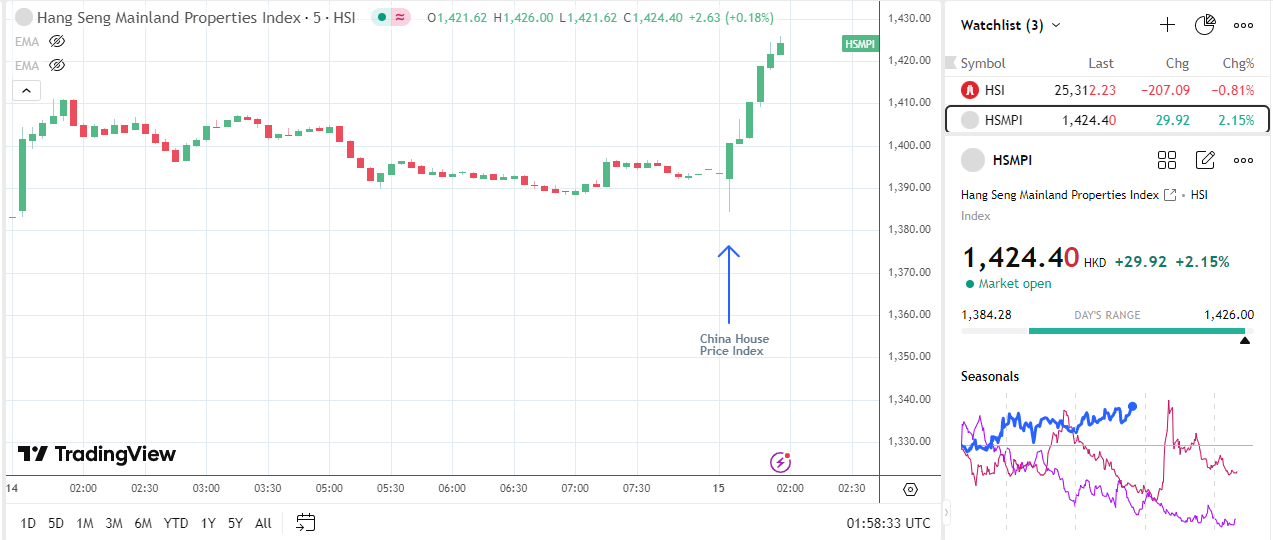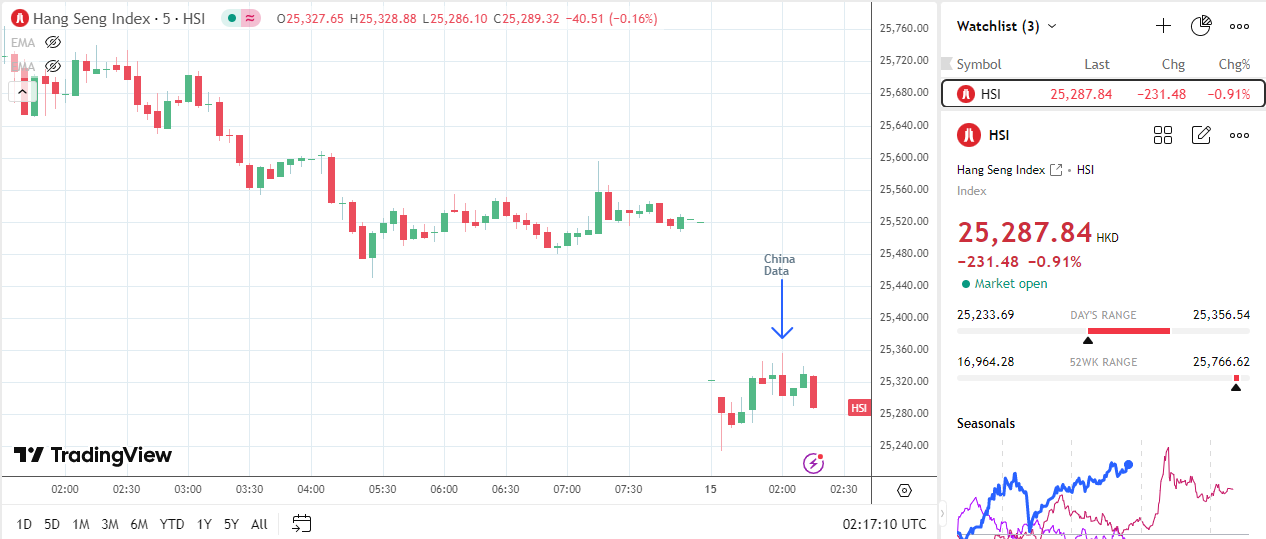China Retail Sales Slip, Industrial Output and Jobs Data Weigh; Hang Seng Dips
Key Points:
- China's July retail sales slowed to 3.7% YoY, missing forecasts and raising calls for further stimulus.
- Industrial output growth slowed to 5.7% YoY, aligning with weaker manufacturing PMI data.
- Unemployment rose to 5.2%, adding pressure on Beijing to address labor market weakness.
China Economic Data Eases Economic Growth Jitters
Fresh Chinese economic data offered mixed signals, soothing property market concerns but stoking fears of slowing consumer demand.
Housing Prices Fall at a Slower Pace
The housing sector continued to show tentative signs of recovery early in the third quarter. The House Price Index fell 2.8% year-on-year (YoY) in July after declining 3.2% in June. July's data raised hopes that Beijing's efforts to stabilize the real estate market had gained traction.
The Hang Seng Mainland Properties Index was up 2.12% following the data release, underscoring investor relief.

HSMPI – 5 Minute Chart – 150825
Consumer Weakness Overshadows Property Gains
Crucial economic data from China highlighted the effect of US tariffs on the industrial sector, consumer sentiment, and domestic consumption.
Retail Sales: +3.7 YoY in July compared with +4.8% in June. Forecast: +4.6%.
Unemployment Rate: Rises from 5% in June to 5.2% in July. Forecast: 5.1%.
Industrial Production: +5.7% YoY in July, down from +6.8% in June. Forecast: +5.9%.
Slower industrial production growth aligned with the July Manufacturing PMI surveys, which revealed a further drop in external demand. After impressive GDP growth in Q2 and export surge in July, today's data suggest US tariffs are beginning to affect China's terms of trade.
Rising unemployment also aligned with the Manufacturing PMIs. Manufacturers continued to cut staffing levels amid rising cost pressures and narrowing profit margins. Deteriorating labor market conditions weighed on domestic consumption, despite Beijing's efforts to boost consumer spending.

Market Reaction to China's Economic Indicators
The Hang Seng Index and the AUD/USD pair reacted to the mixed data as trade uncertainties lingered.
On Friday, August 15, the Hang Seng Index was down 0.8% to 25,315 before the data release. However, the Index dipped to a low of 25,286 in response to the numbers. At the time of writing, the Hang Seng Index was down 0.91% to 25,289.

Hang Seng Index – 5 Minute Chart – 150825
In the forex markets, the AUD/USD pair responded to the China stats, initially rising from $0.64919 to $0.65003 upon the release of the housing sector data. However, the weaker-than-expected retail sales, unemployment, and industrial production numbers weighed on the Aussie dollar. AUD/USD slid from $0.64967 to a low of $0.64893. At the time of writing, the AUD/USD pair was down 0.05% to $0.64894.

AUDUSD – 5 Minute Chart – 150825
Despite the mixed data, recent stimulus measures from Beijing, targeting domestic consumption, cushioned the downside. Furthermore, the latest data may raise expectations of further stimulus measures to bolster the economy.
Earlier reports discussed recent stimulus measures and whether the measures would be sufficient to boost consumption despite labor market and consumer sentiment woes. Today's data suggested more policy support would be needed.
Looking Ahead
Beijing's stimulus measures remain crucial for Mainland China and Hong Kong-listed stocks. However, traders should also closely monitor trade headlines following the extension of the trade war truce. Track the latest developments and policy signals here. Given the latest data, a cautious approach is essential.
